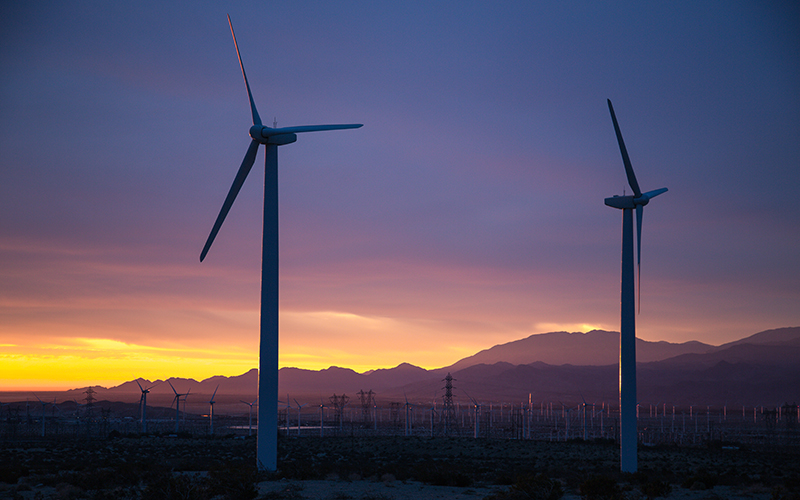
Arizona voters will decide in November what the state’s future energy makeup will be. More than $40 million has been spent to fight for and against Proposition 127, which would require Arizona utility companies get 50 percent of their electricity from renewable sources by 2030. (Photo by Tony Webster/Flickr)
PHOENIX – More than $40 million has been spent to fight for and against a ballot initiative that would change the future of Arizona’s energy mix. Proposition 127 has also been the subject of an Arizona Supreme Court lawsuit and a battle over claims that language from the Attorney General’s Office undermined the initiative.
If approved by voters Nov. 6, it would mandate the state’s regulated utility companies to get more of their energy from solar, wind and other renewable sources.
Supporters say it’s time to take advantage of one of the state’s most abundant resources: sunshine. Opponents say new energy mandates will result in higher costs for ratepayers.
In an interview with Fox News, Dr. Paul Bracken, a Yale University political science and management professor, said the state could be a testing ground for how other states deal with renewable energy standards.
“People who would like more sustainable energies are using the threat of a ballot initiative to put pressure on the state institutions of government and on the power companies themselves to change,” Bracken said. “I think one of the arguments in Arizona, is that for a state with its position in sustainable resources like solar it’s gone very, very slow in terms of particular solar but also wind—it hasn’t done as much as it should – so it could really influence Arizona Public Service and others to move in this direction.”
What the two sides say
Prop 127 would mandate that Arizona utility companies get 50 percent of their electricity from renewable sources by 2030. The Arizona Corporation Commission sets the current standard at 15 percent by 2025; if the initiative passes, the mandate will be included in the state Constitution.
Arizona ranks second behind Nevada in solar energy potential. Yet in 2016, solar accounted for about 5 percent of the state’s net electricity generation, according to the U.S. Energy Information Administration. Wind energy supplied less than 1 percent.
The group Clean Energy for a Healthy Arizona collected hundreds of thousands of signatures to get Prop 127 on the ballot to change that mix.
However, Arizonans for Affordable Electricity filed suit in Maricopa County Superior Court in July, claiming a number of signature-gathering violations by Clean Energy for a Healthy Arizona. Lawyers for the group also said the initiative’s language about “clean” energy was misleading to petition-signers.
Judge Daniel Kiley in August rejected arguments for removing Prop 127 from the ballot. The lawsuit was appealed to the Arizona Supreme Court, which also sided with the defendants, effectively keeping the initiative on the ballot and giving Arizona voters a say in the state’s renewable energy makeup.
“Most Arizonans understand that solar could be a really huge resource here,” said DJ Quinlan, a spokesman for Clean Energy for a Healthy Arizona. “And right now, we’re just not doing it.”
However, Matthew Benson, a spokesman for Arizonans for Affordable Electricity – also known as No on Prop 127 – said Arizonans can expect a hefty increase in utility costs if the measure passes.
“For the typical Arizona family, that means a $1,000 or more in added utility costs over the course of the year,” he said, arguing that low income families and seniors living on fixed incomes would be hit the hardest.
In September, Prop 127 was again mired in controversy. Initiative supporters argued that language added by Attorney General Mark Brnovich’s office to the initiative’s explanation in the voter ballot guide, which the Secretary of State’s Office creates, could make the measure less likely to pass, according to azcentral.com.
The language involves the potential costs to consumers. The phrase “irrespective of cost” was added by the Attorney General’s Office regarding utilities meeting the new energy standards. One official from the Secretary of State’s Office called the added language “eyebrow raising,” according to the azcentral.com article, because that language is not part of the ballot measure itself.
Supporters of Prop 127 also contend Brnovich is in the pocket of Pinnacle West Capital Corp. – the Phoenix-based parent company of Arizona Public Service, the state’s largest utility – because the company donated $425,000 to use against Brnovich’s opponent in the 2014 elections. The money was donated to the Republican Attorneys General Association, which spent $1.8 million to attack Democrat Felecia Rotellini in that election cycle.
Opposing views
Millions of dollars for campaign signs and radio and television ads have been raised by the two groups – and the messages are polar opposite.
For example, Arizonans for Affordable Electricity contends that Prop 127 would force the closure of the nation’s largest nuclear power plant, Palo Verde Nuclear Generating Station in Tonopah, just west of Phoenix. Palo Verde supplies at least 27 percent of Arizona’s electricity, according to the Energy Information Administration, and employs more than 2,500 people, according to APS, which is one of the operators of the facility.
“Closing current power plants, bringing online new resources and all of these costs get passed along to guess who? Ratepayers,” Benson said. “That’s the reason ratepayers will see their costs go up drastically if this becomes part of the Constitution.”
Clean Energy for a Healthy Arizona refutes the idea that Palo Verde would shut down.
“Palo Verde, we believe, is here to stay for its whole life cycle, and we’re supportive of that,” Quinlan said. “Having 50 percent renewable energy sitting next to 30 percent clean energy is a very compatible and healthy thing for our state.”
Nuclear energy emits lower levels of greenhouse gas emissions, making it comparatively “cleaner” than such sources as coal or natural gas, according to Lincoln Davies, a law professor at the University of Utah who studies renewable energy policy in the U.S. and on a global scale.
The group also argues that new infrastructure would be needed to bring more renewable energy to the electrical grid, and that means jobs.
“What would happen is a pretty substantial and markable increase in our solar industry right away, which could really bring in a lot of good jobs and actually cut down on costs,” Quinlan said.
Where the money comes from
Clean Energy for a Healthy Arizona has raised more than $18 million to support Prop 127, according to campaign finance reports. NextGen Climate Action, an environmental advocacy organization founded by California billionaire Tom Steyer, provided more than 99 percent of funds for the group.
Arizonans for Affordable Electricity is largely backed by Pinnacle West Capital Corp., and has raised more than $22 million to oppose Prop 127, according to campaign finance reports.
Davies said it’s not surprising to see large utility companies spending millions of dollars to oppose mandates like Prop 127.
“As the grid has started to evolve,” he said, “as solar has become a really powerful influence in terms of how electricity is getting produced in the United States, you’re starting to see pushback from a lot of utilities and other political constituencies in different states against some of these measures, especially as they become more stringent.”
Similar initiatives are on the ballot next month in Nevada and Washington. Twenty-nine states have renewable portfolio standards that mandate electric utilities generate a certain amount of total energy from renewable sources. California and Hawaii share the highest future requirements: 100 percent renewable energy by 2045. Arizona renewable energy standards are currently set at 15 percent by 2025.
“The idea of these laws was to drive down the cost of renewables over time so that they could be scaled up as technologies and be used across the grid,” Davies said.
The last day to mail in ballots is Oct. 31.
–Video by Rachel Carlton
This story is part of Elemental: Covering Sustainability, a multimedia collaboration between Cronkite News, Arizona PBS, KJZZ, KPCC, Rocky Mountain PBS and PBS SoCal.
Connect with us on Facebook.

